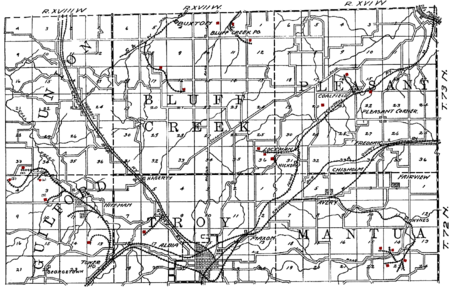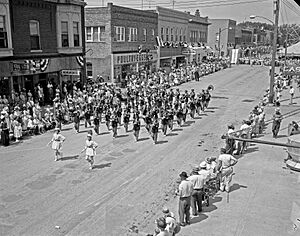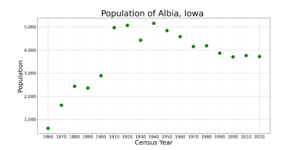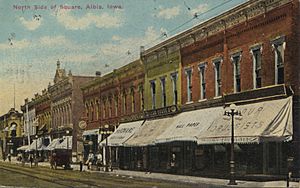Albia, Iowa facts for kids
Quick facts for kids
Albia, Iowa
|
|
|---|---|
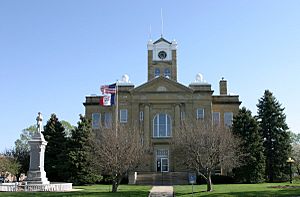
|
|
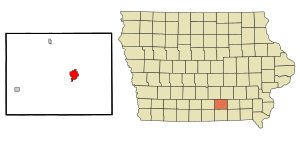
Location within Monroe County and Iowa
|
|
| Country | United States |
| State | Iowa |
| County | Monroe |
| Area | |
| • Total | 3.23 sq mi (8.37 km2) |
| • Land | 3.23 sq mi (8.37 km2) |
| • Water | 0.00 sq mi (0.00 km2) |
| Elevation | 961 ft (293 m) |
| Population
(2020)
|
|
| • Total | 3,721 |
| • Density | 1,151.30/sq mi (444.50/km2) |
| Time zone | UTC-6 (Central (CST)) |
| • Summer (DST) | UTC-5 (CDT) |
| ZIP code |
52531
|
| Area code(s) | 641 |
| FIPS code | 19-00910 |
| GNIS feature ID | 2393905 |
Albia is a city in southern Iowa, United States. It is the main town, or county seat, of Monroe County. In 2020, about 3,721 people lived there.
Albia is famous for its beautiful historic town square. Many buildings in Albia show off Victorian architecture, a popular style from the late 1800s. Every year, the city celebrates "Restoration Days." This event remembers when the town square and buildings were fixed up, starting in the 1960s.
Contents
History of Albia
Albia became an official town in 1856. It was named after Albia, New York. An early settler came from that New York town.
Coal Mining in the Past
In the early 1900s, the area around Albia was important for coal mining. Many small mining towns and company towns were nearby. One famous mining town was Buxton, about 9 miles north of Albia. Buxton was known for having a large Black population. Other former coal towns included Hiteman, Bluff Creek, and Hynes.
On February 14, 1893, there was a coal mine accident. It happened at the Chicago and Iowa mine, west of Albia. This mine had been open since 1877. At the time, about 80 men worked there. A "shot" (a small explosion used to break coal) caused a dust explosion. Sadly, some miners were hurt or lost their lives. This was one of the biggest mine accidents in Iowa during that time.
The number of members in the United Mine Workers union shows how important mining was. In 1902, the union in Albia had 216 members. By 1912, this number grew to 338. This was about 7% of Albia's population back then. Miners in nearby towns like Hiteman and Hynes also joined the union. Their membership grew a lot between 1902 and 1912.
Geography and Climate
Albia covers about 3.19 square miles (8.3 square kilometers) of land. There is no water area within the city limits.
Albia's Climate
Albia has a hot-summer humid continental climate. This means it has warm, humid summers and cold winters. It's often called "Dfa" on climate maps.
| Climate data for Albia, Iowa (elev. 880 feet), 1991–2020 normals, extremes 1894–present | |||||||||||||
|---|---|---|---|---|---|---|---|---|---|---|---|---|---|
| Month | Jan | Feb | Mar | Apr | May | Jun | Jul | Aug | Sep | Oct | Nov | Dec | Year |
| Record high °F (°C) | 71 (22) |
79 (26) |
90 (32) |
93 (34) |
104 (40) |
105 (41) |
110 (43) |
113 (45) |
104 (40) |
96 (36) |
82 (28) |
71 (22) |
113 (45) |
| Mean maximum °F (°C) | 55.1 (12.8) |
59.4 (15.2) |
73.2 (22.9) |
81.2 (27.3) |
86.0 (30.0) |
90.3 (32.4) |
94.2 (34.6) |
93.8 (34.3) |
89.6 (32.0) |
82.6 (28.1) |
70.2 (21.2) |
58.9 (14.9) |
96.0 (35.6) |
| Mean daily maximum °F (°C) | 31.3 (−0.4) |
35.9 (2.2) |
48.7 (9.3) |
61.4 (16.3) |
70.9 (21.6) |
80.2 (26.8) |
84.4 (29.1) |
82.8 (28.2) |
76.0 (24.4) |
63.4 (17.4) |
49.0 (9.4) |
36.5 (2.5) |
60.0 (15.6) |
| Daily mean °F (°C) | 22.2 (−5.4) |
26.3 (−3.2) |
38.3 (3.5) |
50.1 (10.1) |
60.7 (15.9) |
70.4 (21.3) |
74.5 (23.6) |
72.6 (22.6) |
64.8 (18.2) |
52.6 (11.4) |
39.2 (4.0) |
27.9 (−2.3) |
50.0 (10.0) |
| Mean daily minimum °F (°C) | 13.2 (−10.4) |
16.8 (−8.4) |
28.0 (−2.2) |
38.8 (3.8) |
50.5 (10.3) |
60.6 (15.9) |
64.6 (18.1) |
62.4 (16.9) |
53.5 (11.9) |
41.8 (5.4) |
29.5 (−1.4) |
19.3 (−7.1) |
39.9 (4.4) |
| Mean minimum °F (°C) | −9.0 (−22.8) |
−4.1 (−20.1) |
7.1 (−13.8) |
24.1 (−4.4) |
35.1 (1.7) |
47.1 (8.4) |
53.3 (11.8) |
51.2 (10.7) |
37.7 (3.2) |
25.8 (−3.4) |
12.2 (−11.0) |
−1.6 (−18.7) |
−12.8 (−24.9) |
| Record low °F (°C) | −29 (−34) |
−31 (−35) |
−15 (−26) |
8 (−13) |
21 (−6) |
37 (3) |
41 (5) |
36 (2) |
22 (−6) |
5 (−15) |
−8 (−22) |
−26 (−32) |
−31 (−35) |
| Average precipitation inches (mm) | 1.13 (29) |
1.49 (38) |
2.02 (51) |
3.77 (96) |
4.86 (123) |
5.18 (132) |
4.02 (102) |
4.04 (103) |
3.57 (91) |
2.80 (71) |
2.14 (54) |
1.47 (37) |
36.49 (927) |
| Average snowfall inches (cm) | 7.4 (19) |
8.4 (21) |
3.9 (9.9) |
1.1 (2.8) |
0.0 (0.0) |
0.0 (0.0) |
0.0 (0.0) |
0.0 (0.0) |
0.0 (0.0) |
0.4 (1.0) |
1.9 (4.8) |
6.9 (18) |
30 (76.5) |
| Average precipitation days (≥ 0.01 in) | 6.6 | 7.3 | 8.3 | 10.8 | 12.4 | 11.7 | 8.9 | 9.1 | 7.8 | 8.4 | 6.8 | 7.0 | 105.1 |
| Average snowy days (≥ 0.1 in) | 4.3 | 4.4 | 2.1 | 0.4 | 0.0 | 0.0 | 0.0 | 0.0 | 0.0 | 0.2 | 1.1 | 3.7 | 16.2 |
| Source 1: NOAA | |||||||||||||
| Source 2: National Weather Service | |||||||||||||
Population of Albia
| Historical populations | ||
|---|---|---|
| Year | Pop. | ±% |
| 1860 | 620 | — |
| 1870 | 1,621 | +161.5% |
| 1880 | 2,435 | +50.2% |
| 1890 | 2,359 | −3.1% |
| 1900 | 2,889 | +22.5% |
| 1910 | 4,969 | +72.0% |
| 1920 | 5,067 | +2.0% |
| 1930 | 4,425 | −12.7% |
| 1940 | 5,157 | +16.5% |
| 1950 | 4,838 | −6.2% |
| 1960 | 4,582 | −5.3% |
| 1970 | 4,151 | −9.4% |
| 1980 | 4,184 | +0.8% |
| 1990 | 3,870 | −7.5% |
| 2000 | 3,706 | −4.2% |
| 2010 | 3,766 | +1.6% |
| 2020 | 3,721 | −1.2% |
| Iowa Data Center Source: |
||
2020 Census Data
In 2020, Albia had 3,721 people living in 1,545 households. About 943 of these were families. The city had about 1,151 people per square mile. There were 1,703 housing units in total.
Most of the people in Albia (94.1%) were White. About 0.5% were Black or African American. About 0.3% were Asian. Around 1.1% were from other races, and 4.0% were from two or more races. About 2.4% of the population was Hispanic or Latino.
In the households, 32.2% had children under 18. About 42.5% were married couples. The average age in Albia was 38.6 years. About 27.5% of residents were under 20 years old. About 19.5% were 65 years or older. The city had slightly more females (51.8%) than males (48.2%).
2010 Census Data
In 2010, Albia had 3,766 people living in 1,540 households. About 960 of these were families. The population density was about 1,180 people per square mile. There were 1,763 housing units.
The racial makeup of the city was mostly White (97.5%). About 0.3% were African American, and 0.2% were Native American. About 0.3% were Asian. About 0.4% were from other races, and 1.3% were from two or more races. About 1.9% of the population was Hispanic or Latino.
In 2010, 30.6% of households had children under 18. The average household size was 2.37 people. The average family size was 2.98 people. The median age in Albia was 40 years. About 25.1% of residents were under 18. About 19.8% were 65 years or older. The city had slightly more females (51.5%) than males (48.5%).
Education in Albia
The Albia Community School District runs the public schools in the area. These schools serve the children and families living in Albia.
Fun Activities in Albia
Albia offers several places for fun and recreation:
- Monroe Aquatic Center: This center has two water slides, a low dive, a high dive, and a special area for children. It also has basketball hoops in the water and lockers.
- Washington Park: A great place to relax and enjoy the outdoors.
- City Park: This park includes a basketball court, a baseball field, and a tennis court. It also has a playground with swings for younger kids.
Notable People from Albia
Many interesting people have connections to Albia:
- George Bennard (1873–1958), who wrote the famous song "The Old Rugged Cross".
- Nathan E. Kendall (1868–1936), a politician who served in the U.S. House of Representatives and was the 23rd Governor of Iowa.
- John Judge (born 1944), a politician who served in the Iowa State Senate.
- Patty Judge (born 1943), a politician who served as a State Senator, Iowa Secretary of Agriculture, and Lieutenant Governor of Iowa.
- Johnny Miler (1910–1976), a boxer who competed in the 1932 Summer Olympics. He even defeated Joe Louis in an amateur fight.
- Wendell Nedderman (1921–2019), a college leader who was president of The University of Texas at Arlington for many years.
- Theodore Bolivar Perry, a politician.
- James Stevens (1892–1971), a musician and writer, known for his book Paul Bunyan.
- Fred Townsend (1862–1918), a politician and Iowa legislator, and a football player.
- Josiah T. Young (1831–1907), a politician who was Iowa's Secretary of State and mayor of Albia.
- Taylor Yarkosky (born 1977), a politician who is a member of the Florida House of Representatives.
Images for kids
See also
 In Spanish: Albia para niños
In Spanish: Albia para niños


